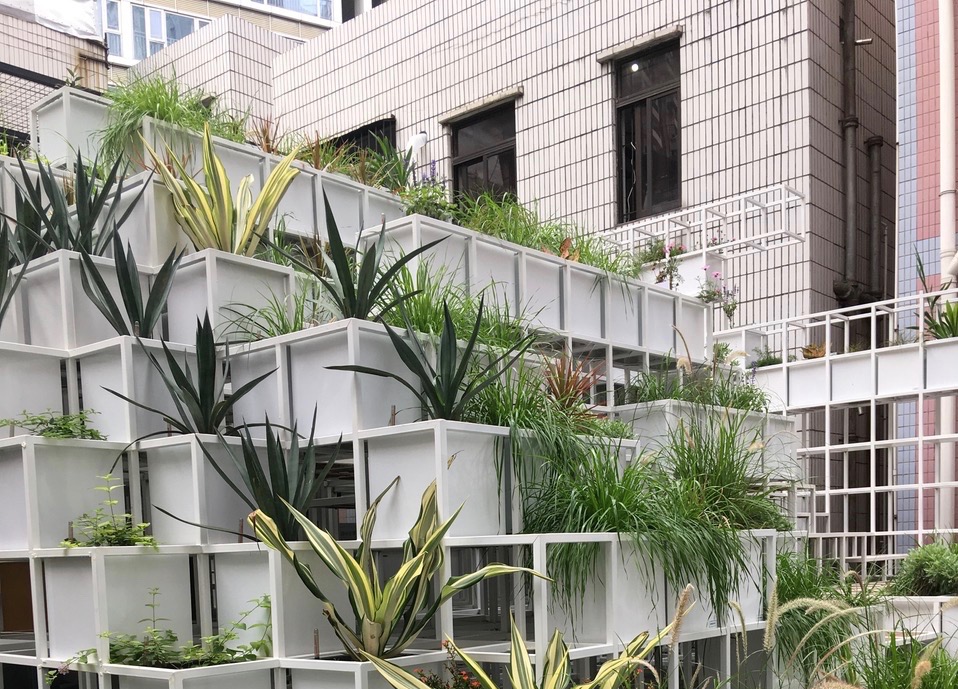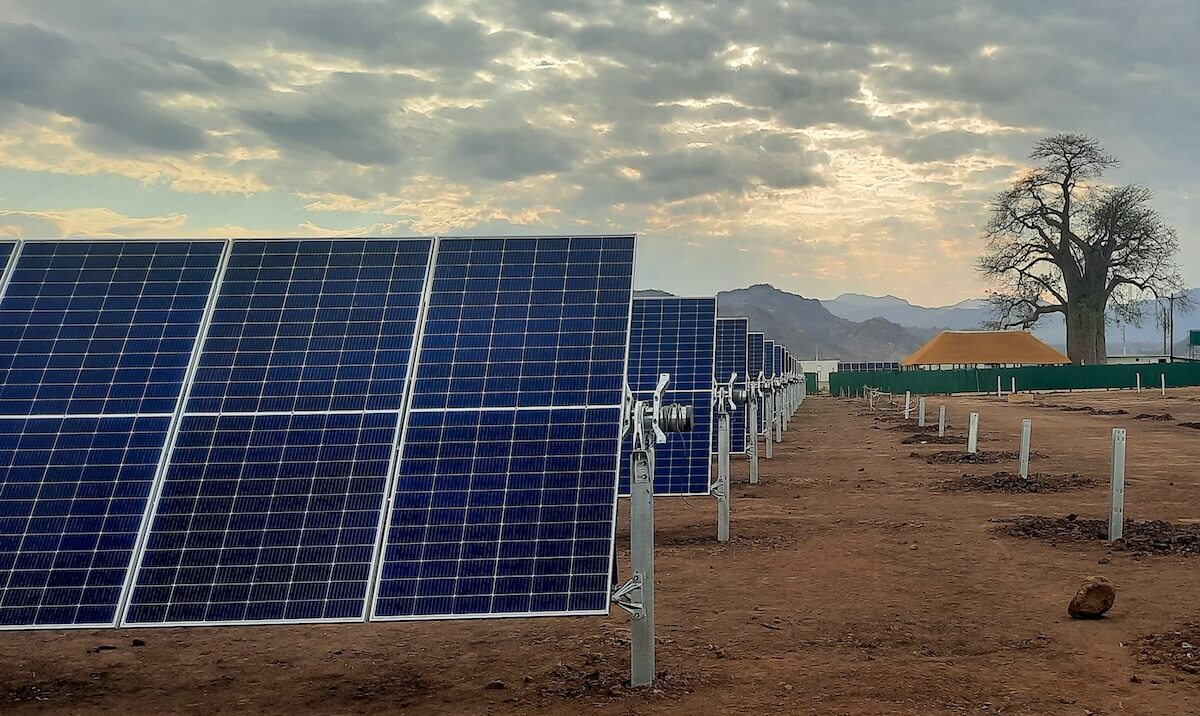SHENZEN, China, ImpactAlpha – When spring and summer rains hit the densely populated urban village of Gangxia near the center of Shenzhen, narrow streets become cascades of rainwater. Waters rise at least ankle-deep; in sustained downpours, they reach the knees or higher.
Rooftops become pools as gutter systems clog. There is little green space to absorb rain that reaches the ground.
For a glimpse of a different future, walk down a narrow side street in Gangxia where an apartment building for young professionals has been outfitted with gutter systems that capture excess rainwater in a large tank. The roof is covered with cubes of potted plants that absorb much of the water that used to pool there.
The project, one of about 100 in development around Shenzhen, aims to showcase how easily a dense urban village can reduce flooding. With a few tweaks, a system like this can capture up to 70 percent of the rain that hits the roof, with some gathered for reuse and the rest stopped from reaching the cement below by the plant system.
China has been on a path to create about 30 “sponge cities.” By 2030, it aims to have 80 percent of urban areas across the country sponge-like, with projects to absorb, store and purify rainwater to deal with both floods and water shortages. That’s in line with U.N. Sustainable Development Goal No. 11, “Make cities and human settlements inclusive, safe, resilient and sustainable,” also by 2030.
>>MORE: The surprising leader in the $36 billion global market for ‘payments for ecosystem services’
The cumulative investment in sponge city projects in Beijing, Shanghai, Shenzhen, Wuhan and other areas could reach 1.9 trillion yuan [$300 billion USD] by the end of 2020. It’s a recognition that in arid areas of northern China, cities didn’t factor in heavy rains as they rapidly expanded and added roadways. That left sewer systems inadequate to deal with sudden storms or to capture rainfall for times of need. Huge storms have caused major damage and death in Beijing, Tianjin, Wuhan and Nanjing in recent years.
Chinese cities join a growing number of communities around the world creating green infrastructure to manage floods, pollution and water waste from storms and seasonal rains. In Washington, D.C., a $25 million environmental impact bond is financing open space, permeable pavement and other systems to control damage from stormwater runoff. Atlanta and Baltimore are raising smaller amounts for similar projects. In Copenhagen, the $1.4 billion “Cloudburst” management plan will direct stormwater to safe runoff areas.
Moving Mountains
The demonstration project in Gangxia is a partnership between The Nature Conservancy and a local NGO called Glocal. If scaled up to cover just 50% or more of the buildings, it could reduce localized flooding and urban heating costs, and clean canyon-effect air pollution in Shenzhen, a city of nearly 20 million, says Yu Xin, a local organizer with TNC.
“Sometimes we call this an urban mountain,” Yu says, pointing to the terraced system of plants that cover the roof. “If you think about the scale of the whole city and all the rooftops we have in the city, there are probably only 10% that have some kind of rooftop garden. There’s big potential to do something.”
Across Shenzhen around 100 sponge-city model projects are being considered for subsidies to help them to scale up. Shenzhen’s two local government subsidy funds can steer capital to projects.
On another project, TNC has partnered with Shenzhen-based internet giant Tencent to make its new headquarters a sponge-city building. The design integrates hundreds of censors to record rainfall data, heat island impacts of the building, and other indicators. Yu said Tencent has paid for the project itself. Tencent CEO Pony Ma is a board member of TNC.
“It is not just about the construction of the building, but about the management,” Yu said. “This could be a demo for other office buildings.”
Financing Sponge Cities
China is already a leader in providing “payments for ecosystem services” in rural areas also subject to flooding. After a series of floods and droughts two decades ago, the Chinese government established the Sloping Land Conservation Program (focused on converting steep farmland to forest and grassland) and the Natural Forest Conservation Program (to encourage logging bans and reforestation). The two programs distributed between $50 billion and $100 billion from 2000 to 2010 and are set to grow.
Most funding for the sponge cities efforts, likewise, comes from central and local government budgets. Even public-private-partnerships typically involve government- and state-owned enterprise cooperation. So far, there appears to be little interest from private investors in China’s sponge city projects, largely because they are not actively encouraged to participate.
“You want the business sector to have access to these developments,” Yu said. “Right now it is mainly the state-owned companies that have access to subsidies, or a budget from environmental-protection treatment fees. It is not really a business model.”
TNC is researching how financing structures for green stormwater and water conservation infrastructure in places such as Washington, D.C. and Philadelphia could be used in China, Yu said. Green bonds could be a way for impact investors to add water conservation projects to their portfolios. The opacity of those bonds in China does not give investors great ability to trace the funds to the project level. Another idea would be to create a funding stream for companies that deal with stormwater management by charging the cost to companies or residents, Yu said.
“You still need to get your money back,” Yu said. “Right now it is purely from the government. Small companies are interested in looking at this market, but they don’t feel there is a concrete business model or benefit from doing such things.”
State-owned enterprises are likely to remain the norm, says Wenmei Ha, head of the China Water Management Team at Arcadis Asia, a consulting group from the Netherlands that has been involved in Wuhan’s sponge city planning for the past two years. “The definition and models of [public private partnerships] may differ from how we see it in the West,” she says.
Ha said that early sponge city projects have concentrated on low-impact development projects — similar to the TNC green rooftops — but that these are only one part of solving urban water problems. Other areas that need attention include outdated sewer systems and methods of dealing with extreme weather.
“It can be relatively challenging for foreign companies to be involved with large-scale projects in China, as our business may be limited only to certain projects and procedures due to a lack of certain licenses,” Ha said.
She said the government-led initiative could move fast and get big, even at the expense of in-depth assessment and planning. “Once the government decides that a project is right to go ahead with,” She said, “the job can be done very quickly.”











